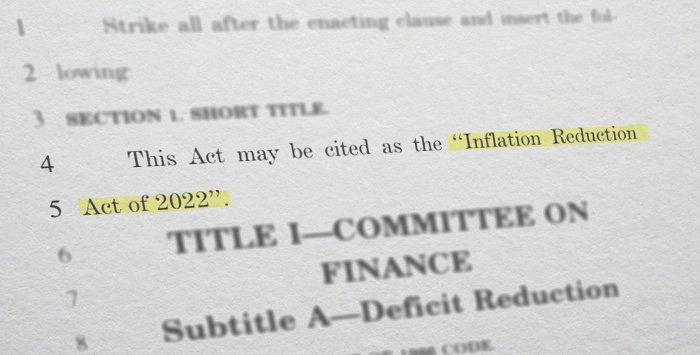After months of stalled progress, laws that might lengthen the American Rescue Plan’s medical health insurance subsidy enhancements is again on the desk within the U.S. Senate. That’s nice information for the 13 million People who’re eligible for premium tax credit (subsidies) that offset the price of market (change) medical health insurance.
The Inflation Discount Act was introduced in late July, and a vote within the Senate is predicted subsequent week. The laws – which is each a local weather and healthcare invoice – addresses a number of urgent priorities, together with a three-year extension of the subsidy enhancements delivered by the American Rescue Plan.
How would the Inflation Discount Act have an effect on market subsidies?
If the Senate and Home each go the Inflation Discount Act, the present market subsidy construction will stay in place by way of the top of 2025, as an alternative of expiring on the finish of 2022. This might assist market buyers in a number of methods:
- The subsidy cliff would proceed to not exist for the subsequent three years, that means that People with earnings above 400% of the federal poverty stage (FPL) would nonetheless be doubtlessly eligible for subsidies. Subsidy eligibility would rely upon the proportion of earnings that an individual must spend on the benchmark plan, and subsidies can be out there – even with earnings above 400% of FPL – if the benchmark plan would in any other case be greater than 8.5% of family earnings.
- Subsidies would proceed to be bigger than they have been pre-ARP. The dimensions of the subsidies varies by earnings, age, and space, however they restrict the after-subsidy price of the benchmark plan to a pre-determined proportion of family earnings. That proportion of earnings is on a sliding scale, and the ARP decreased it to 0% – 8.5%. Below the ACA, it had been 2% – 9.5%, with small annual inflation changes. With the ARP in place, the 0% – 8.5% scale has been used for 2021 and 2022 well being plans. And the Inflation Discount Act would lock in that very same scale by way of the top of 2025.
- The continued market particular enrollment interval for subsidy-eligible candidates with family earnings as much as 150% of FPL would proceed to be out there by way of 2025. HHS has clarified that this enrollment alternative is simply out there so long as benchmark plans are premium-free for consumers at this earnings stage. If the ACA’s scale have been to return, subsidy-eligible candidates on the decrease finish of the earnings scale would pay roughly 2% of their earnings for the benchmark plan. However with the ARP’s scale in place, these candidates pay 0% of their earnings for the benchmark plan. The Inflation Discount Act would proceed that for 3 extra years, permitting the particular enrollment alternative to proceed as effectively.
Full-price premiums will nonetheless change in 2023; throughout greater than half the states to this point, the general proposed common fee improve is about 8% – a lot of which isn’t associated as to whether the ARP subsidies are prolonged. However most enrollees don’t pay full worth. In 2022, about 89% of market enrollees obtain premium subsidies. HHS estimates that 3 million individuals will lose their protection altogether – whereas 10 million will see their subsidies decline or disappear – if the ARP subsidies are usually not prolonged below the Inflation Discount Act.
To be clear, even when the Inflation Discount Act is enacted, there might be fluctuations in subsidy quantities and after-subsidy premiums for renewing plans. This occurs yearly, relying on how a lot the benchmark premium modifications (maintaining in thoughts that the benchmark plan is usually a totally different plan from one yr to the subsequent) and the way a lot the price of a selected plan modifications.
However with the Inflation Discount Act, total affordability will stay the identical as it’s this yr, because the benchmark plan would proceed to price the identical proportion of earnings that individuals pay this yr. (We do must remember the fact that the benchmark plan is usually a totally different plan from one yr to the subsequent, new plans is likely to be out there for the approaching yr, and charges for different plans relative to the benchmark plan may change.)
With out the Inflation Discount Act, protection would develop into a lot much less inexpensive in 2023. HHS calculations present that if the ARP subsidy enhancements hadn’t been in impact this yr, the premiums that enrollees paid themselves – after subsidies have been utilized – would have been 53% greater within the 33 states that use HealthCare.gov. That’s the form of state of affairs that thousands and thousands of market enrollees would see in 2023 with out the Inflation Discount Act.
What does the Inflation Discount Act not do?
Though the Inflation Discount Act is a dramatically scaled-back model of 2021’s Construct Again Higher Act (which handed the Home however then stalled within the Senate), the invoice’s extension of the present ARP subsidy enhancements is similar to the ARP subsidy enhancement extension that was within the Construct Again Higher Act.
However there have been some further Construct Again Higher Act subsidy provisions that aren’t included within the Inflation Discount Act: The Inflation Discount Act is not going to shut the Medicaid protection hole that also exists in 11 states. It is not going to reinstate the momentary unemployment-related subsidies that have been out there in 2021. And it’ll not change the best way affordability is decided for employer-sponsored well being protection.
Will the Inflation Discount Act go?
Passage of the Inflation Discount Act just isn’t a positive factor. It wants the backing of all 50 members of the Senate’s Democratic Caucus so as to go, and that’s not a given.
Home Speaker Nancy Pelosi (D-CA) has stated that the Home will go the measure if and after they obtain it from the Senate. Though the margin isn’t fairly as tight within the Home, Democrats can lose at most 4 votes so as to go the invoice in that chamber.
What does the Inflation Discount Act laws imply for 2023 open enrollment?
Open enrollment for 2023 well being protection begins on November 1. If the Inflation Discount Act is enacted this summer season, customers ought to count on to see the identical common stage of affordability for 2023 that that they had in 2022.
However this at all times varies from one space to a different relying on elements akin to new insurers coming into a market, or state reinsurance applications that carry down full-price charges and lead to decrease subsidies. Even with the Inflation Discount Act in place, that form of subsidy and premium fluctuation will nonetheless occur in some areas and for some plans.
If the Inflation Discount Act doesn’t go, web premiums will improve sharply for many present enrollees when their protection renews for 2023. Some enrollees might want to change to lower-cost plans so as to maintain their premiums inexpensive.
No matter whether or not the ARP subsidy enhancements proceed into 2023 or expire on the finish of 2022, will probably be vital to rigorously contemplate all choices throughout open enrollment. There might be shifting insurer participation in some areas, altering premiums, and new plan designs.
Individuals who purchase their very own medical health insurance might want to contemplate all the out there plans and choose the one that most closely fits their wants and finances. Which will or might not be the identical plan that they had this yr, no matter what occurs with the ARP subsidy enhancements.
Louise Norris is an particular person medical health insurance dealer who has been writing about medical health insurance and well being reform since 2006. She has written dozens of opinions and academic items in regards to the Inexpensive Care Act for healthinsurance.org. Her state well being change updates are often cited by media who cowl well being reform and by different medical health insurance specialists.




